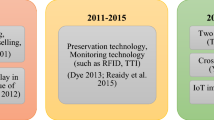Abstract
In this paper, an inventory system with production, remanufacturing and refurbishing activities is studied, over a finite planning horizon. The demand is assumed time varying. Used products are returned by customers, and after inspection, they can be classified either as “remanufacturable” or as “refurbishable” items. The remanufacturing process brings “remanufacturable” items up to quality standards that are as rigorous as those of new items. The refurbished items are sold to a secondary market at a reduced price. In order to control the system, two types of policies are considered. For these two policies, a procedure is proposed that determines the order and remanufacturing quantities and the inventory level of returned (used) items at the start of the inspection and recovery processes, which minimize the total costs.


Similar content being viewed by others
References
Schrady, D.A.: A deterministic inventory model for repairable items. Nav. Res. Logist. Q. 14(3), 391–398 (1967)
Richter, K.: Pure and mixed strategies for the EOQ repair and waste disposal problem. Oper. Res. Spektrum 19(2), 123–129 (1997)
Dobos, I., Richter, K.: An extended production/recycling model with stationary demand and return rates. Int. J. Prod. Econ. 90(3), 311–323 (2004)
Teunter, R.H.: Economic ordering quantities for recoverable item inventory system. Nav. Res. Logist. 48(6), 484–495 (2001)
Teunter, R.H.: Lot-sizing for inventory systems with product recovery. Comput. Ind. Eng. 46(3), 431–441 (2004)
Konstantaras, I., Papachristos, S.: A note on: developing an exact solution for an inventory system with product recovery. Int. J. Prod. Econ. 111(2), 707–712 (2008)
Konstantaras, I., Papachristos, S.: Lotsizing for a single product recovery system with backordering. Int. J. Prod. Res. 44(10), 2031–2045 (2006)
El-Saadany, A.M.A., Jaber, M.Y.: A production/remanufacture model with returns subassemblies managed differently. Int. J. Prod. Econ. 133(1), 119–126 (2011)
Konstantaras, I., Skouri, K.: Lot sizing for a single product recovery system with variable setup numbers. Eur. J. Oper. Res. 203(2), 326–335 (2010)
Yuan, K.F., Gao, Y.: Inventory decisionmaking models for a closedloop supply chain system. Int. J. Prod. Res. 48(20), 6155–6187 (2010)
Liu, N., Kim, Y., Hwang, H.: An optimal operating policy for the production system with rework. Comput. Ind. Eng. 56(3), 874–887 (2009)
Omar, M., Yeo, I.: A model for a production–repair system under a time-varying demand process. Int. J. Prod. Econ. 119(1), 17–23 (2009)
Fleischmann, M., Krikke, H.R., Dekker, R., Flapper, S.D.: A characterisation of logistics networks for product recovery. Omega: Int. J. Manag. Sci. 28(6), 653–666 (2000)
Loomba, A.P.S., Nakashima, K.: Enhancing value in reverse supply chains by sorting before product recovery. Prod. Plan. Control 23(23), 205215 (2012)
Konstantaras, I., Skouri, K., Jaber, M.Y.: Lot sizing for a recoverable product with inspection and sorting. Comput. Ind. Eng. 58(3), 452–462 (2010)
Al-Khamis, T.M., Benkherouf, L., Omar, M.A.: Optimal policies for a finite-horizon batching inventory model. Int. J. Syst. Sci. 45(10), 2196–2202 (2014)
Henery, R.J.: Inventory replenishment policy for increasing demand. J. Oper. Res. Soc. 30(7), 611–617 (1979)
Skouri, K., Papachristos, S.: A continuous review inventory model, with deteriorating items, timevarying demand, linear replenishment cost, partially time-varying backlogging. Appl. Math. Model. 26(5), 603–617 (2002)
Benkherouf, L., Gilding, B.H.: On a class of optimization problems for finite time horizon models. SIAM J. Control Optim. 48(2), 993–1030 (2009)
Omar, M., Smith, D.K.: An optimal batch size for a production system under linearly increasing-time varying demand process. Comput. Ind. Eng. 42(1), 35–42 (2002)
El-Saadany, A.M.A., Jaber, M.Y.: A production/remanufacturing inventory model with price and quality dependant return rate. Comput. Ind. Eng. 58(3), 352–362 (2010)
Pinedo, M.L.: Scheduling, Algorithms and Systems. Springer, NewYork (2012)
Acknowledgments
The authors wish to thank the two anonymous reviewers for their critical and very constructive comments. A part of this work was done during a visit of Lakdere Benkherouf to the university of Ioannina.
Author information
Authors and Affiliations
Corresponding author
Additional information
Communicated by Jamal Ouenniche.
Appendix
Appendix
Firstly, we calculate the area under \(I_{1}(t)\) [see (27) and (30)] on the interval \(t_{i-1}\le t\le t_{i}\) which help for the derivation of holding cost for used products:
If \(\varDelta _1\) denotes the area under the function \(I_1(t)\) from time 0 to H, then it follows that
For the area under \(I_{2}(t)\) on the interval \(t_{i-1}\le t\le t_{i}\), we obtain using (33) and (35):
Next, we compute the quantity \(\sum _{i=1}^{n_{1}-1}(t_{i}-t_{i-1})L_{i}\). This is equal to:
If \(\varDelta _2\) denotes the area under the function \(I_2(t)\) from 0 to H, then it follows from (61) to (62) that \(\varDelta _2:=\)
The last two terms of the equation refer to the area in the last period. Finally, we get \(\varDelta _2=\)
Rights and permissions
About this article
Cite this article
Benkherouf, L., Skouri, K. & Konstantaras, I. Optimal Control of Production, Remanufacturing and Refurbishing Activities in a Finite Planning Horizon Inventory System. J Optim Theory Appl 168, 677–698 (2016). https://doi.org/10.1007/s10957-015-0741-9
Received:
Accepted:
Published:
Issue Date:
DOI: https://doi.org/10.1007/s10957-015-0741-9




